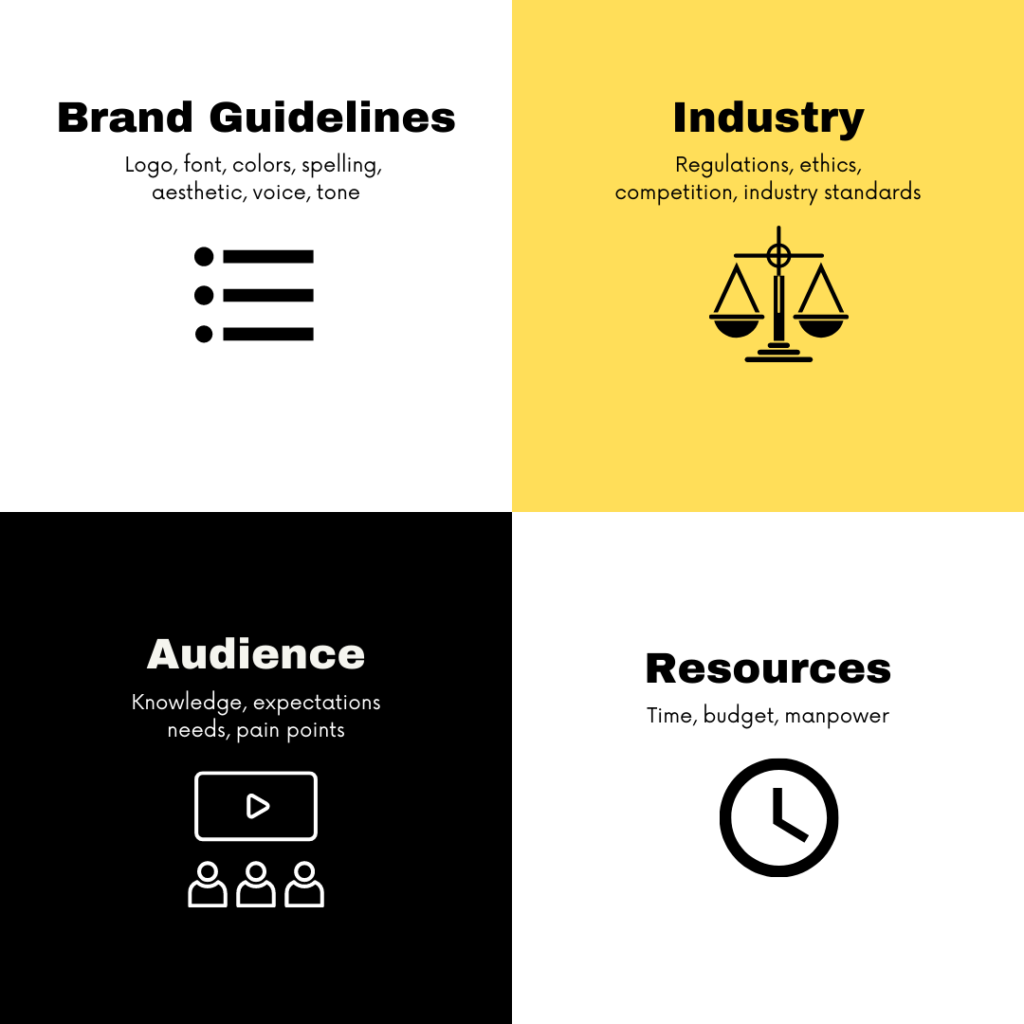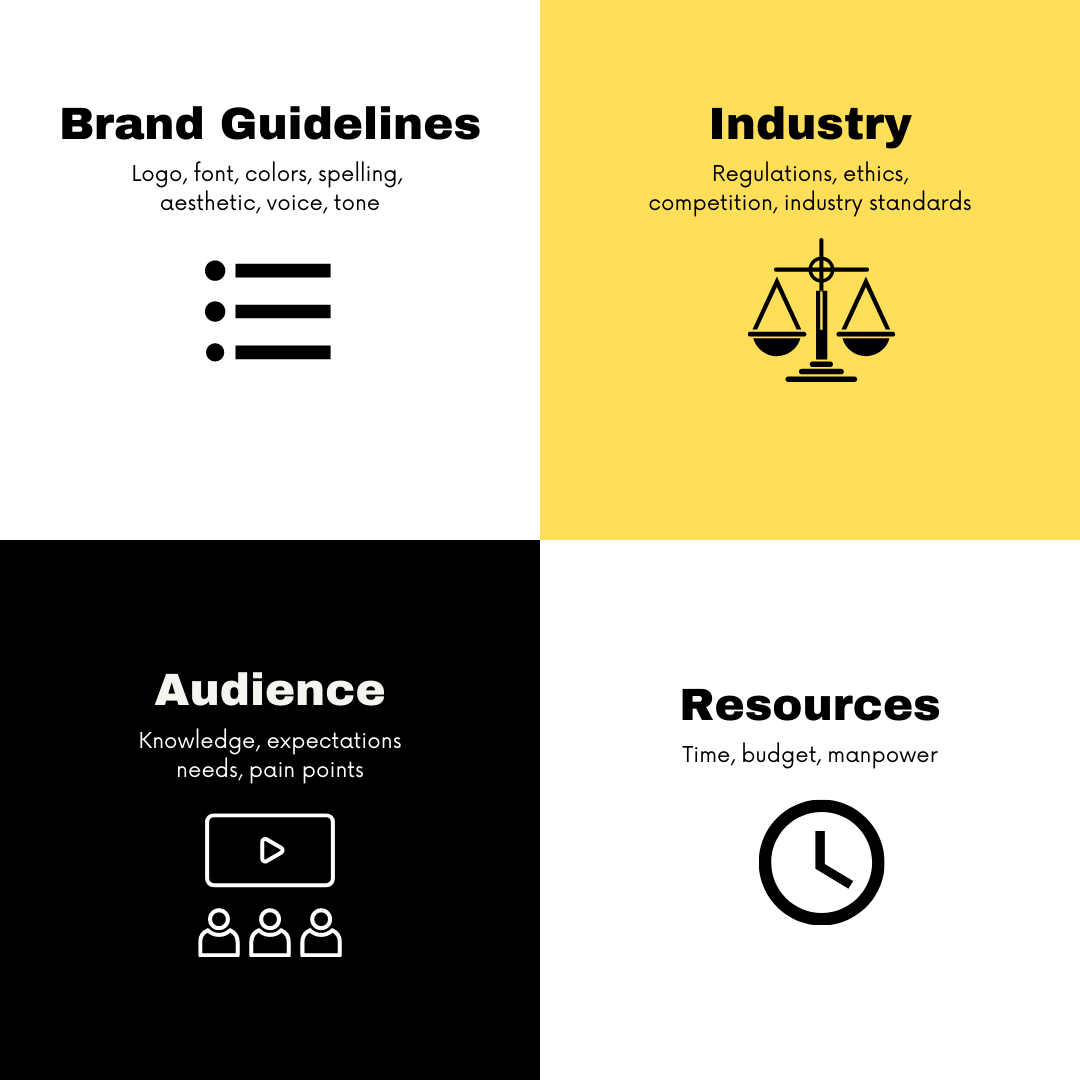At Found Conference, Nisha Kashyap, Creative Director at Sociallyin, spoke on the content creation process. There, she discussed the importance of a consistent brainstorming, execution, and review system, and the value of knowing the “why” and the “wow” behind your story. Nisha also mentioned the need to work within certain boxes: even if your brand is a massively creative and wacky enterprise, you aren’t creating content in a vacuum, and you don’t have unlimited resources. How can you recognize those boundaries – and make creative and engaging content that stays on-brand and relevant?
It’s all about naming your boxes. Keep these constraints in mind as you work through the creation process — and find ways to use these boxes to your advantage.
Where and When
Let’s start with the basics. The setting of your content, or the “where and when,” defines where the content lives and when it lands there. Although setting seems obvious, it can be one of the biggest limitations to your content.
The “where” refers to the platform or distribution channel. Is it going on your website, your Facebook page, or some other managed platform? The location of your content informs content type, size, and audience. Dig back through your content on that channel to see what performed well. You can also check out your competitors, look for channel-specific trends, and determine which areas of that channel you can own. Twitter’s new Stories feature might not be for everyone — but, hey, maybe it’s the right place to launch your news-oriented infographics!
The “when” refers to the time period in which you’ll share this content. Are you creating a short-term campaign for Instagram, or a series of billboards that may launch over a year? As you create your content, consider the timeliness of the underlying concept. For example, don’t post a pool-party themed ad in December…and maybe don’t post one in the middle of a pandemic, either. Be aware of what’s going on outside of your brand: that awareness ensures your audience can relate to and engage with your content.
Brand guidelines
Branding restrictions may not seem fun, but limitations to colors, fonts, and tone of voice ensures consistency throughout your deliverables. There’s a reason we have brand guidelines in place! Whether you’re working for yourself or for a client, sticking to your brand increases brand recognition and brand loyalty. A brand style guide also makes it much easier for multiple staffers to create cohesive content – without pulling in outside help on graphics, language, or other elements.
To create consistency and maintain your brand authority, make sure you know your brand guidelines. If your organization doesn’t have a complete brand style guide, it likely has guides on logo use, the style of articles and emails, or colors. Often, the guidelines are the work of a branding agency — but, eventually, you’ll find a question that isn’t answered by the guide. Work across teams to firm up those guidelines when questions arise. And, make them available to everyone working on your content
Your brand style guide may include:
- Logo design: The logo itself, places the logo may be uses, logo variations, and uses of those logo variations.
- Font styles: typography, including size and spacing.
- Colors: primary and secondary colors, and the ways in which full- and partial-color branding may be used.
- Style and spelling rules: spellings of certain words (think “color” versus “colour”) and grammatical rules.
- Photography guidelines: guides for background colors, exposures, and filters.
- Voice and tone: A list of do’s and don’ts for the use of language and emotion.
We get it: it’s not fun to find out you’re using the “wrong” color of green in the middle of your St. Patty’s Day campaign. But, sticking within brand guidelines can also keep your authority in place and prevent less-than-professional content.
Resources
Your resources can present their own limitations. What kind of personnel hours, equipment, and budget can you deliver to your project? Often, your resources can present a limitation — and you need to acknowledge that from the very conception of your content idea.
First things first: make sure to calculate your ROI. If you’re planning a massive campaign, during your most important season, for your most profitable product, you should pull out all the stops. Contracting for perfectly-shot aerial video or partnering with a paid spokesman may make sense. But, if you’re just looking for a Facebook post for this Tuesday — you probably shouldn’t blow half your marketing budget.
Chances are, you know what you do well. You should know what mediums your audience finds most engaging. Focus on building on your strengths, and prioritize, prioritize, prioritize.
Time
Not only do you need to know what time to post something, you need to know how much time you have to create it. How much time do you have to create a piece of content? If you’re working on a new piece over a month, you could involve your entire team, A/B test, and brainstorm like crazy. But, if you’re creating content in just a few days, you’ll need to figure out how to create something amazing on that deadline.
Here’s one secret about resources: in an increasing number of industries, you don’t have to hide what you don’t have. Professional videography isn’t in the budget this year? Look to influencer marketing, informal live content shot on your phone, and user-provided content for low-budget video that resonates with your customers. Or, ditch video entirely! The medium may be popular, but it’s a waste of your time if it sucks up resources without getting eyeballs.
Just as with equipment, money, and talent, your team needs to budget its time. Luckily, content marketing is constantly shifting: creating dynamic, timely content is often better than creating a perfect, behemoth, singular thing. Don’t spend all your time budget in one place, and keep an eye toward the future.
Industry regulations
We’ve spoken on this blog about creating relatable content in red-taped industries. Whether you’re a non-profit, a government agency, or a business operating under regulations of any kind, there’s likely content you can’t publish. Consider the following throughout your content creation process:
- What may not be ethical or legal to share? This stuff is usually personal client information, especially in the non-profit world. Consider ways to talk about your users as a whole. Focus on humanity without focusing on individual humans.
- Where can you market? Are paid ads available to you, and, if so, which kinds? Certain industries are prohibited from advertising on Facebook or AdWords. Others are simply prohibited from certain types of audience targeting.
- Is there certain language that must be included in your messaging? In more industries such as finance and home insurance, you may need to include certain disclosures or include disclaimers.
Industry regulations can feel like a burden — but content creation just requires a bit more creativity, with an eye toward compliance.
Audience expectations
Another boundary lies in your audience’s expectation. A key component of content marketing is the ability to accurately match your content to user intent — and a failure to do so means that users may bail out of disappointment. While you’re creating content, consider things like:
- Audience education level: Introduce new product lines with informational content, not hard sales — and consider creating content that demonstrates your product instead of simply pitching it.
- Audience familiarity with your brand: Your returning customers retain their past experiences with your brand — and they expect the same feel every time they interface with you. If you’re trying a new direction on a certain piece, incorporate elements of your existing brand. If you’re doing a full rebrand, acknowledge it with some sort of “new look, same great flavor” type of language.
- Audience familiarity with your competitors: Do your users expect your site or page to behave like your competitors? Are there industry standards or page layouts that are universally recognized? We love creativity, but don’t make information hard to find: every credit card website has an “apply here” button, and that’s absolutely okay.
- Audience expectation of your tone: Understand the tone that your audience expects, and that stakeholders expect you to deliver. If you’re working in government, finance, or healthcare, a jovial tone probably isn’t the right voice. But, that doesn’t mean that you must stick to dry numbers and stats. Think about the reason why your audience is interested in your content, and speak to that interest.
Knowing your audience is content marketing 101. You want your site to create a good experience for users at every part of the funnel, and to retain your VIP customers. However, while you need to consider your audience’s expectations of you, check your expectation of your audience. Don’t limit yourself to your current customers! Content should be fresh, engaging, and usable to new users and demographics.

Thinking outside the box — while working within one
All of these content creation boxes can present challenges to the bright-eyed marketer. However, acknowledging the reality of your budget, the weight of your audience expectations, and the importance of brand guidelines helps streamline your content creation process. By thinking about the parameters in which you’re working, your team will make the best use of your resources and your time. Knowing your boxes can free you to expend your creative energies in the way that makes sense for your brand.
Not sure where to start working through your marketing constraints? Schedule a discovery call with us — and get your content creation machine moving.

